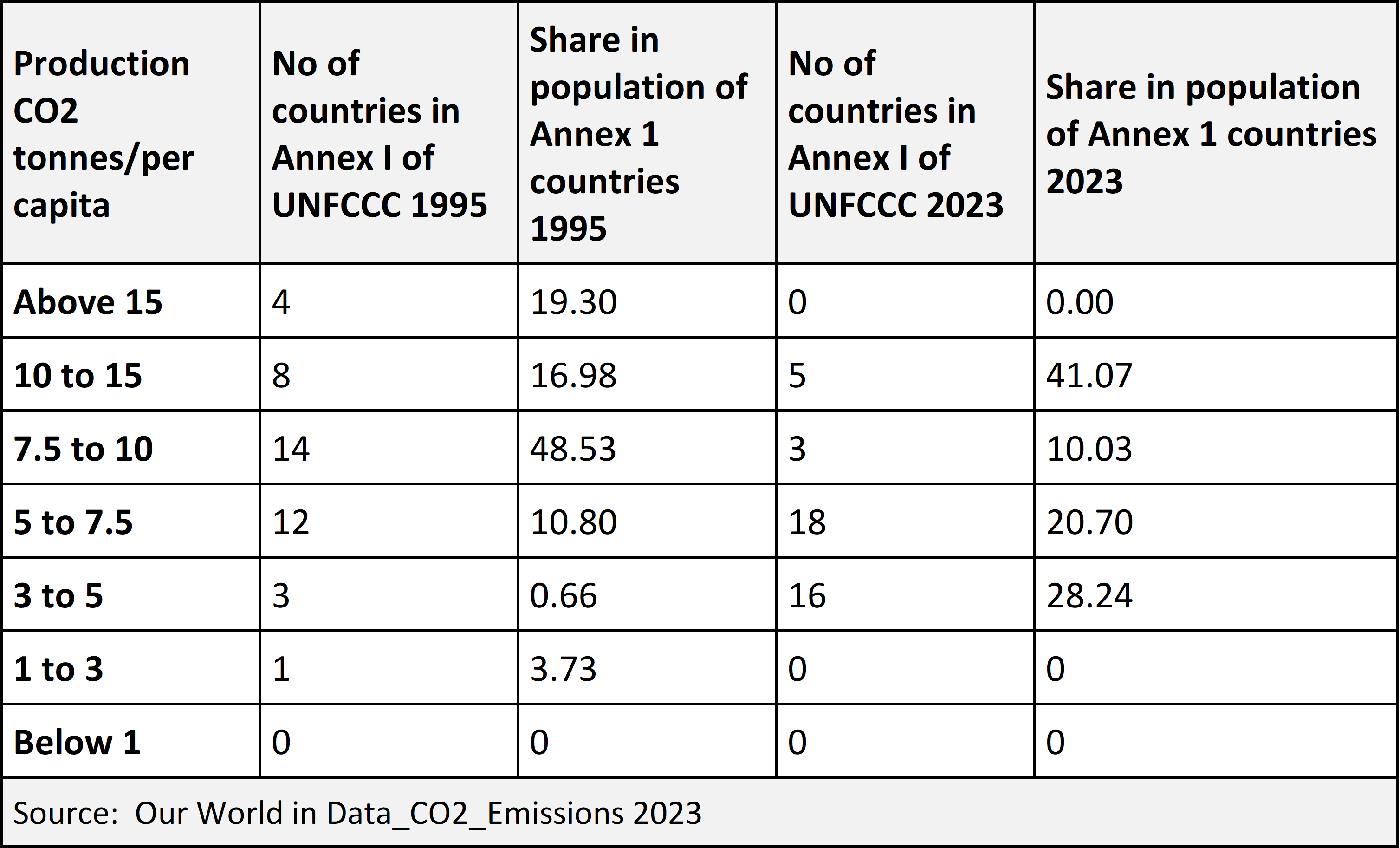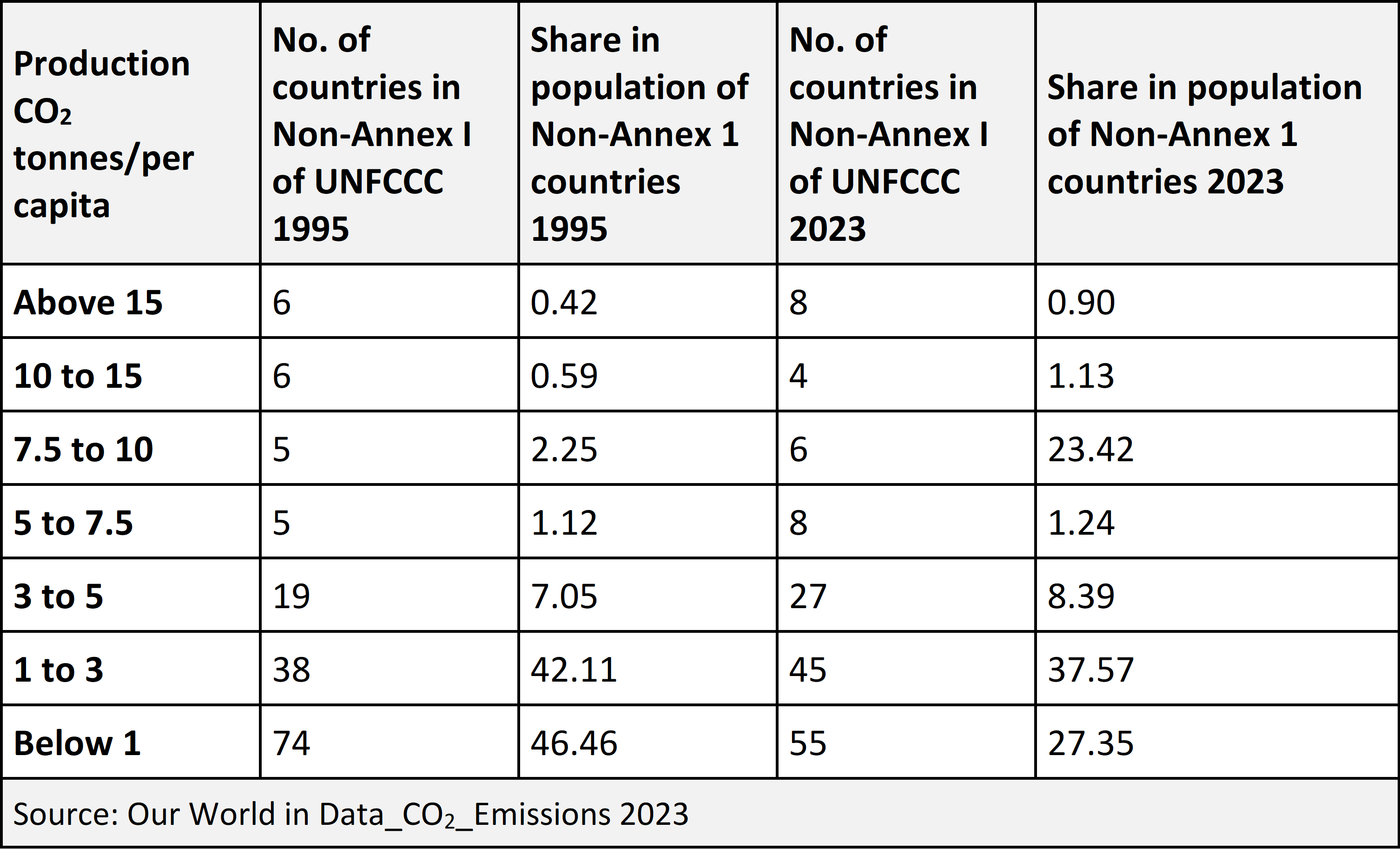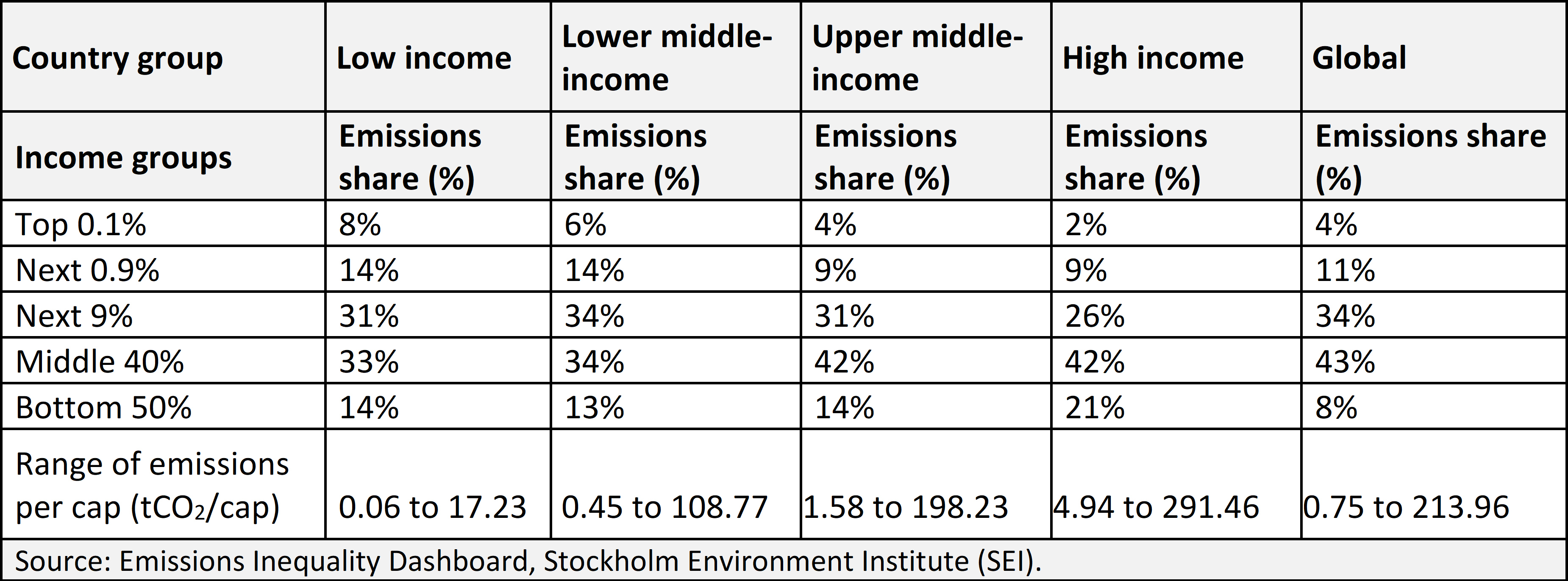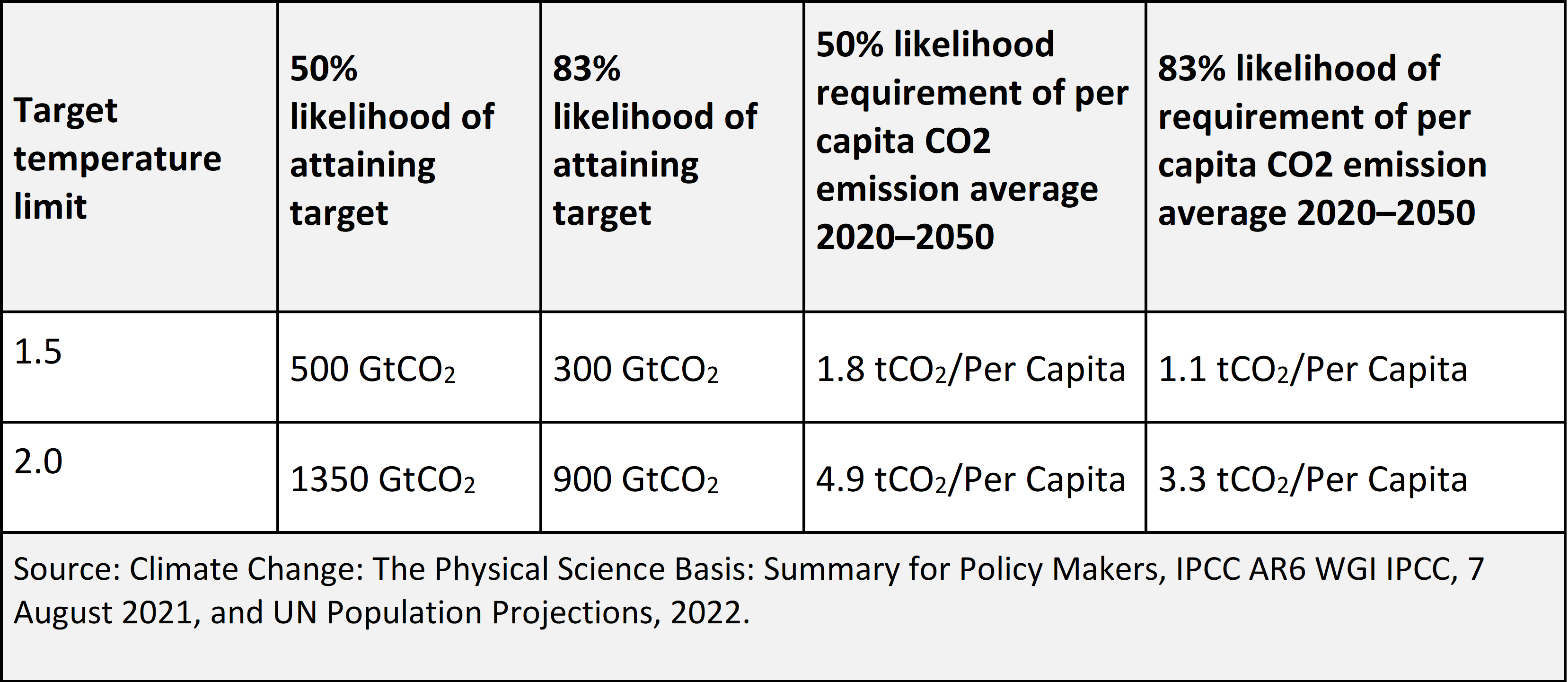The 30th meeting of the Conference of Parties (COP) to the UN Framework Convention on Climate Change (UNFCCC) will take place from November 10 to 21 in Belem, Brazil. Progress towards the goals set out in the UNFCCC has been slow, even though these goals were given greater emphasis in the Paris Agreement at COP 2015. There is also mounting evidence that global temperatures are already rising. Given this context, the central task of COP30 is to establish principles that will accelerate both global cooperation and national action.
The 2023 data on cumulative emissions by countries shows that Annex 1 countries who have 16% of the global population still account for 63% of cumulative CO2 emissions, while the Non-Annex 1 countries account for 37%.
The UNFCCC is strongly influenced by the Intergovernmental Panel on Climate Change (IPCC). The IPCC has consistently emphasised that climate impacts result from cumulative emissions over time. This understanding is reflected in the differing responsibilities for action assigned to Annex 1 and Non-Annex 1 countries.
Annex 1 consisted of countries which were members of the Organisation for Economic Cooperation and Development (OECD) and the economies in transition (EIT) in Eastern and Central Europe. This group could be described as the developed economies of the early 1990s. The rest of the countries were placed in the Non-Annex 1 category and were described as developing countries.
The obligation for reduction in emissions of CO2 and other greenhouse gas (GHG) emissions was placed on Annex 1. In the case of the developing countries, the Berlin Mandate agreed at the first meeting of the COP in Berlin explicitly stated that “the largest share of historical and current global emissions of greenhouse gases has originated in developed countries” and “that the per capita emissions in developing countries are still relatively low and that the share of global emissions originating in developing countries will grow to meet their social and development needs”. This difference was justified on the principle of common but differentiated responsibility (CBDR).
The case for common but differentiated responsibility remains. The magnitude of cumulative emissions between countries has changed to reduce the share of Annex 1 countries since 1995. However, the 2023 data on cumulative emissions by countries shows that Annex 1 countries who have 16% of the global population still account for 63% of cumulative CO2 emissions, while the Non-Annex 1 countries account for 37%, of which roughly four-fifth is from upper middle-income countries.
The share of the low and low middle-income countries that have 49% of the global population is barely 7% of the total emissions. This reinforces the case for common but differentiated responsibility. However, over the years, the arguments have shifted from cumulative emissions to current emissions, which are increasing, understandably from developing countries as envisaged by the Berlin Mandate. This is what led to the dilution of common but differentiated responsibility and the transition to voluntary emission reductions by all countries, with most countries committing to a target net-zero date.
The consensus that all countries must work towards emission control and ultimate reduction to net-zero emissions is desirable because of the growing evidence of rising climate change threats. However, this is not a basis for neglecting the principle of common but differentiated responsibility. The case for more vigorous action by developed countries relative to developing ones remains valid.
Per capita CO2 emissions in 2023 were 14.5 tonnes in Australia and 2.1 tonnes in India. Clearly any assessment of the strength of emission reduction should be based on per capita emissions and not total annual emissions.
The first point that one must note is that countries differ greatly in size and the number of people who are citizens. That is why the evaluation of the impact on global climate change must compare the per capita emissions of each country, not the total amount.
To illustrate the point, Australia on its total CO2 emissions in 2023 of 383 million tonnes would be considered much less of a problem than India with its total CO2 emissions of 3,062 million tonnes. However, per capita CO2 emissions in that year were 14.5 tonnes in Australia and 2.1 tonnes in India. Clearly any assessment of the strength of emission reduction should be based on per capita emissions and not total annual emissions.
Table 1 and Table 2 present the country-wise distribution of per capita per year CO2 emissions in 1995 and 2023.
Table 1: Per Capita Co2 Emissions in Annex 1 Countries

Table 2: Per Capita Co2 Emissions in Non-Annex 1 Countries

This country-wise data shows that Annex 1 countries have moved downwards in their per capita emissions and Non-Annex 1 countries have moved up. But note also the substantial continuing difference between the two groups.
In 2023, 100 Non-Annex 1 countries had per capita emissions below 3 tonnes of CO2 while there was no Annex 1 country in the below 3 tonnes of CO2 category. Note also that countries with 41% of Annex 1 population are in the above 10 tonnes of CO2 per capita category while only 2% of Non-Annex 1 countries are in it.
The difference between the Annex 1 and Non-Annex 1 countries that was recognised at the beginning of UNFCCC has not disappeared. The country-wise assessment presented in Tables 1 and 2 is one proof of this thesis.
Note also the more aggregate numbers. The average per capita emission of Annex 1 countries in 2022 was 9.4 tonnes of CO2, while that of Non-Annex 1 countries was 3.8 tonnes of CO2.
There is another dimension worth noting and that is the difference between the usual measure of CO2 emission, which is based on production within the country, and the measure based on the consumption in the country. In the case of the Annex 1 countries, the consumption-based per capita CO2 estimate in 2022 was 10.3 tonnes, significantly higher than the 2022 production-based estimate of 9.4 tonnes. 1Note that the consumption-based estimates are not available for three small Annex 1 countries—Iceland, Lichtenstein, and Monaco. For Non-Annex 1 countries, the difference is the other way around, with a consumption-based estimate of 3.6 tonnes of CO2 per capita, which was less than the production-based estimate of 3.8 tonnes of CO2 per capita in 2022. 2The consumption emissions data for Non-Annex 1 countries is available for 77 large countries that account for 89% of the total Non-Annex 1 population in 2022.
Part of the reason for the higher end of per capita emissions in Non-Annex 1 countries is that development since 1995 has diluted the developing country status of Non-Annex 1—it now includes six countries that are members of the OECD—Chile, Columbia, Costa Rica, Israel, Mexico, and South Korea. The 2022 per capita gross domestic product (GDP) at 2011 prices of all of them is above $14,000, and that would make them high-income countries.
Non-Annex 1 also includes many oil producer countries that fall in the high-income category. Twenty Non-Annex 1 countries are included in the World Bank list of high-income countries. In reviving the common but differentiated responsibility principle in the UNFCCC, this may have to be considered.
A global evaluation by the Stockholm Environment Institute reported the following for 2019—the richest 10% accounted for 49% of emissions, the middle 40% for 43%, and the poorest 50% for just 8%.
However, the developed countries that are part of Annex 1 have focused more on the emission growth in China, which has increased sharply from 2.9tCO2/per capita in 1995 to 8.4tCO2/per capita in 2023, an increase from 0.7 times of the global average of tCO2/per capita in 1995 to 1.8 times that in 2023. Unfortunately, because of the focus on total CO2 emissions rather than per capita emissions, India has also become a target for accelerated climate action by developed states. Even in 2023, India’s per capita emissions were below half the global average of CO2/per capita.
The principle of common but differentiated responsibility is central to UNFCCC negotiations. However, it is equally important to recognise that, within each country, policies developed to meet global commitments must also address substantial internal differences. In particular, there are significant disparities between high-income and low-income households.
A global evaluation by the Stockholm Environment Institute reported the following for 2019—the richest 10% accounted for 49% of emissions, the middle 40% for 43%, and the poorest 50% for just 8%. 3Emily Ghosh, Anisha Nazareth, Guozhong Wang, Sivan Kartha, Eric Kemp-Benedict (2021): Emissions Inequality Dashboard, Stockholm Environment Institute (SEI). https://emissions-inequality.org Table 3 presents data for income-based grouping of countries.
Table 3: Distribution of Emissions by Country Groups, 2019

As Table 3 shows, the share in emissions of the richest 10% of the population ranges from 44% to 53% in developing countries and is 37% in high-income countries. Note, however, the substantial rise in the range of per capita emissions from low-income to high-income countries. The message from this is that national policies for climate mitigation should focus clearly on the top 10% upper income groups who globally account for 49% of emissions.
The strategy of common but differentiated responsibility should not be based solely on the original distinction between Annex 1 and Non-Annex 1 countries. This is because the Non-Annex 1 group now includes 20 countries classified by the World Bank as high-income.
Instead, differentiation should be determined by differences in per capita emissions between countries. The rationale for focusing on per capita emissions lies in the need for strategies that can limit future emissions. This approach is essential to keeping the rise in average global temperature within the 1.5–2.0°C range.
In its sixth assessment report (2021), the IPCC estimated the amount of CO₂ emissions from 2020 to 2050 that would be consistent with specific temperature limits. These estimates are expressed as per capita emissions, based on UN projections of global population changes. The results are shown in Table 4.
Table 4: Estimated Remaining Carbon Budgets from 2020 to 2050

The reality is that countries are falling short of their targets for 2030. Between 2020 and 2024, cumulative CO2 emissions have gone up by 189 billion tonnes, leaving a tighter requirement for the future than what is shown in Table 4.
Focusing on the amount of future emissions we can afford as a global community does not assign responsibility based on past emissions. Annex 1 countries are unwilling to accept such historical responsibility. Therefore, the proposal here is limited to ensuring a fair sharing of allowable future emissions.
This approach requires us to treat all humans as equal and to agree on a shared, per capita target. This target should be set as an average for the years leading up to 2050, or any declared net-zero deadline.
This approach requires us to treat all humans as equal and to agree on a shared, per capita target. This target should be set as an average for the years leading up to 2050, or any declared net-zero deadline.
If we consider the total allowable emissions until 2050, along with the number of people who will be responsible for those emissions during this period, it is possible to set an annual emissions target for all countries. This target would be an average of 3 tonnes of CO₂ per capita for each year, up to the country’s announced net-zero target year.
However, this target alone will not be sufficient to meet the 1.5°C goal, which currently seems unrealistic. If, instead, the global per capita average until 2050 is accepted and implemented immediately, there is a chance to revive the 1.5°C goal. This could also allow for a reduction in the agreed global per capita emissions target.
Among Annex 1 countries, as well as one-third of the Non-Annex 1 countries, per capita emissions exceed 3 tonnes of CO₂ per person per year. In contrast, two-thirds of Non-Annex 1 countries have per capita emissions below this target level.
All countries should be required, in addition to announcing their net-zero date, to prepare a plan for reaching their net-zero target year. This plan should include measures designed to limit average emissions over the coming decades to 3 tonnes of CO₂ per capita annually.
This emphasis is crucial because few countries have provided detailed roadmaps for achieving their net-zero targets. Analysis of major emitting countries shows a significant problem—when their net-zero target dates and 2030 goals are examined, even a steady reduction in emissions would result in average per capita emissions that exceed 3 tonnes of CO₂ per year.
Table 5: Average Annual Per Capita Emissions (Tco2) from 2019 to Target Net-Zero Year

On the basis of the data in Table 5, one can state that the principles that should accelerate global cooperation and national action should be as follows:
● The principle of common but differentiated responsibility should be strongly affirmed to assert the greater immediate responsibility for climate mitigation action by countries with high emission rates.
● The distinction between two groups analogous to the earlier distinction between Annex 1 and Non-Annex 1 countries should be based on annual per capita emissions.
● The standard for the division of countries into two groups should be 3 tonnes of CO2 per capita per year.
● Every country should set a target year for achieving net-zero emissions. In addition, each country must specify a policy structure with a timeline that aims to keep average annual per capita emissions at 3 tonnes of CO₂ until its net-zero target year.
● Domestic policies must also recognise the substantial responsibility of high-income households with their high per capita rate of emission.
A major challenge at the November COP30 meeting will be the opposition from the United States. The current U.S. president is openly critical of the need for climate mitigation action. One possible solution is to pursue an agreement within the framework of the Paris Agreement, which has treaty status and from which the US has withdrawn. At this stage, the most realistic outcome may be an agreement to establish a working group under the Paris Agreement. This group would detail what countries that adhere to the agreement must specify as their path to net-zero emissions.
Global cooperation on climate change cannot be limited to simply setting emission reduction goals. It is also needed to develop effective policies to achieve these goals.
The US will remain out, and this will increase climate risks. But hopefully an agreement among all the other countries will affect public opinion in the US on climate issues and lead to political pressure on the government to rejoin the global action on climate mitigation. Do note that the US has a significant capacity in the development of technologies for climate mitigation.
Global cooperation on climate change cannot be limited to simply setting emission reduction goals. It is also needed to develop effective policies to achieve these goals. In addition, global cooperation can help countries address the challenges of adaptation and resilience to climate change.
Managing the special financial requirements for climate action, as well as for facilitating technology cooperation and provision, is also essential. However, the foundation of global cooperation on climate change has to be based on agreed goals on emission reduction.
Nitin Desai served as Under-Secretary-General of the United Nations from 1992 to 2003. He was Deputy Secretary-General of the 1992 Rio Earth Summit (United Nations Conference on Environment and Development) and later Secretary-General of the 2002 World Summit on Sustainable Development in Johannesburg. Email: desaind@icloud.com









